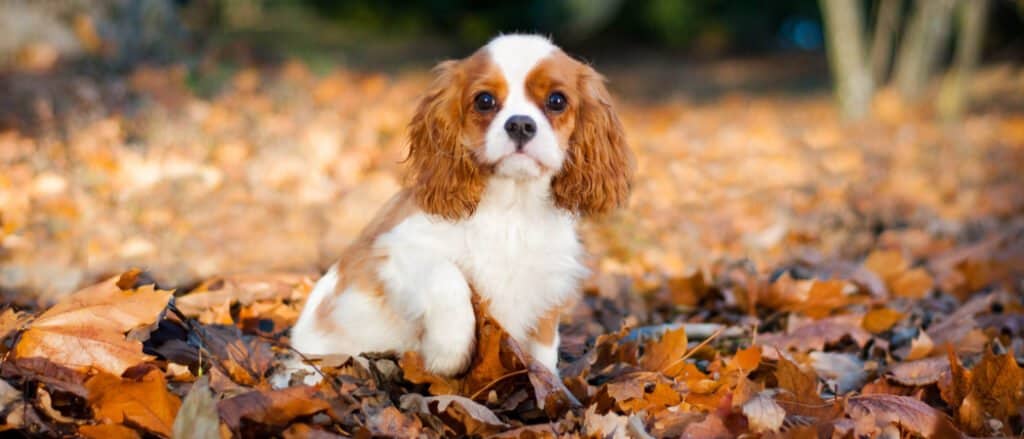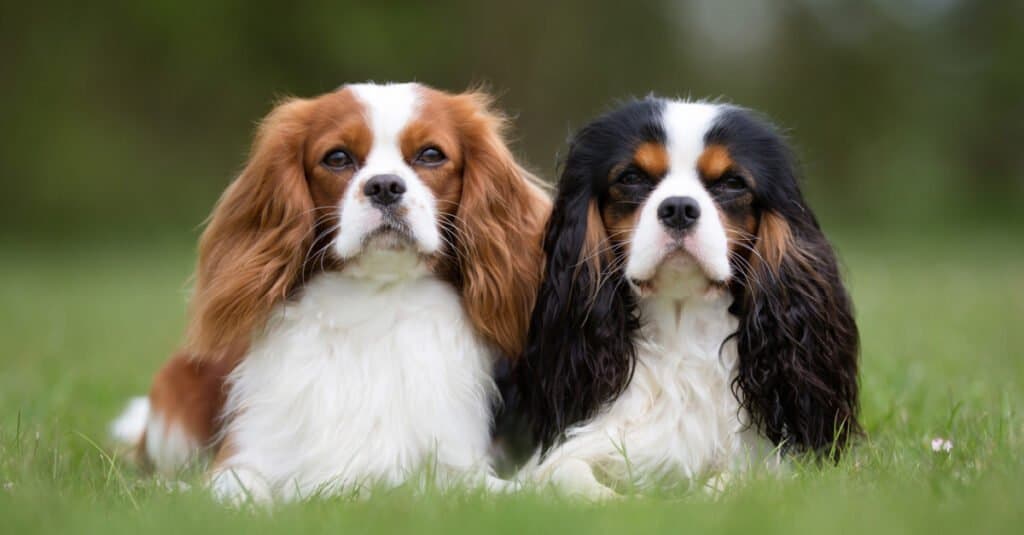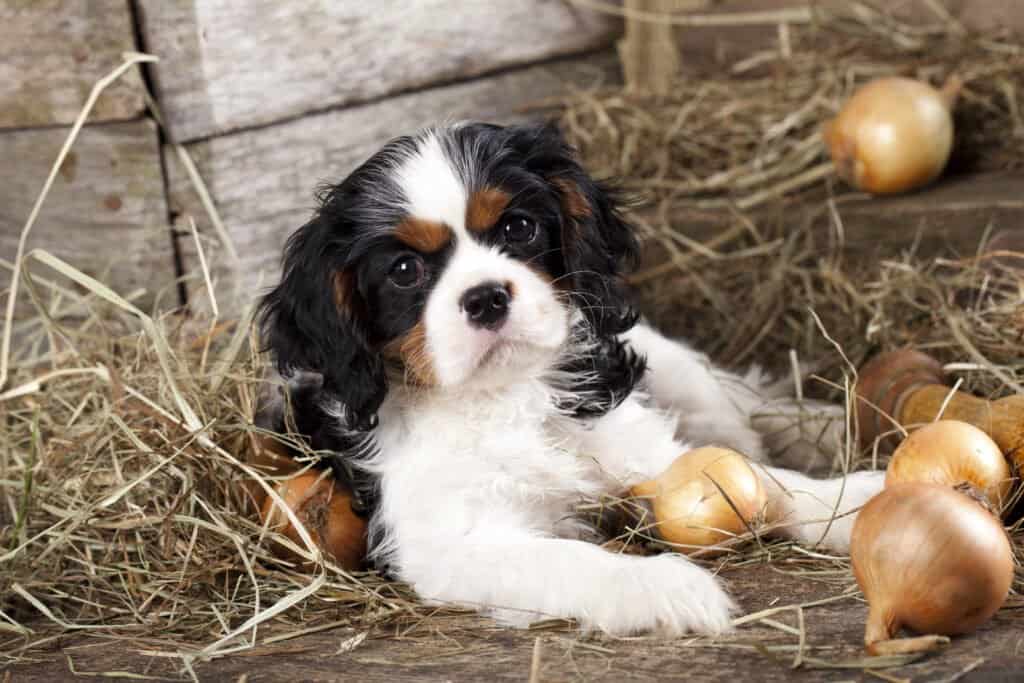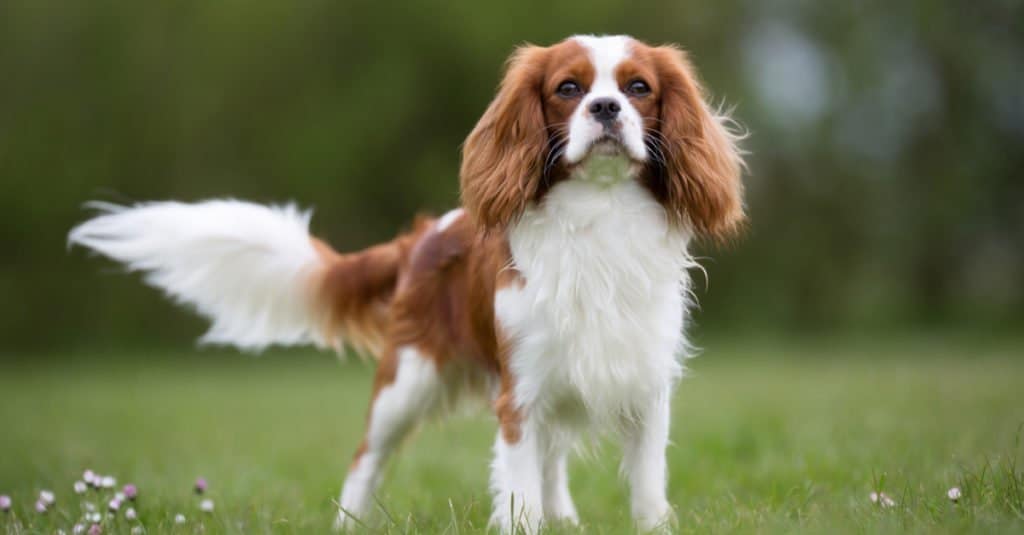Are you bringing home a new Cavalier King Charles spaniel puppy? We’ve got you covered with everything you need to know about your pup’s progression from puppyhood to adulthood!
In this detailed guide, we discuss the breed’s month to month growth chart, diet tips, and training tips. Let’s get started!
History Of the Cavalier King Charles Spaniel

The
Cavalier King Charles spaniel
is known for forming close bonds with their owners.
©Sarune Kairyte/Shutterstock.com
The Cavalier King Charles spaniel breed was created over the last 100 years. They are descendants of the toy spaniel that has been around for quite some time. The toy spaniel is believed to date back to the 16th century. Dogs that resemble them have been featured in paintings from that time period.
The original toy spaniels were treasured by royal families, with many taking their spaniels everywhere. They say Mary, Queen of Scots even brought her toy spaniel with her as she walked to her beheading! This proves just how important these pups were to their royal owners.
Once the 17th century rolled around, many royal families became interested in brachycephalic breeds like the Pug. This led to breeding pugs with toy spaniels. This act eventually led to the short-faced features seen in the Cavalier King Charles spaniel today.
The short-faced breed did not make its way to the U.S. until the 1940’s. The breed was finally recognized by the AKC as a separate spaniel in 1995, and their popularity has grown since.
Unique Traits of the Cavalier King Charles Spaniel
Part of what makes the Cavalier King Charles spaniel so special is that they are family dogs at their core. Not only are they incredibly friendly and gentle, but they greatly enjoy spending time with those they love. Whether curled up in your lap or accompanying you on an adventure, they are happy to be with you.
Another unique trait of this dog is that they are known to be supreme tail waggers! Many Cavalier breeders strive to create pups that always wag their tail, as it is a trait that so many love. If this breed wasn’t adorable enough, their constant tail wagging seals the deal!
Cavalier King Charles Spaniel: Growth and Weight Chart by Age
| Age | Male Weight | Female Weight |
| Birth | Under 1 pound | Under 1 pound |
| 1 Month | 0.75 – 1.8 pounds | 0.4 – 1.5 pounds |
| 6 Weeks | 1.5 – 2.5 pounds | 1 – 2.2 pounds |
| 2 Months | 2 – 5.6 pounds | 1.5 – 4.5 pounds |
| 3 Months | 5.4 – 7.6 pounds | 3.6 – 6.5 pounds |
| 4 Months | 7.4 – 10.3 pounds | 4 – 7.5 pounds |
| 5 Months | 9.2 – 12.8 pounds | 7 – 9.5 pounds |
| 6 Months | 10.3 – 14.1 pounds | 8 – 11 pounds |
| 7 Months | 11.4 – 15.6 pounds | 9.3 – 12.2 pounds |
| 8 Months | 12.0 – 16.5 pounds | 9.8 – 12.5 pounds |
| 9 Months | 12.3 – 17.1 pounds | 10 – 13 pounds |
| 10 Months | 12.6 – 17.5 pounds | 11.5 – 13.5 pounds |
| 11 Months | 12.8 – 17.9 pounds | 11.6 – 13.8 pounds |
| 12 Months | 13.0 – 18.1 pounds | 12 – 13.9 pounds |
| 2 Years | 13 – 18.5 pounds | 12- 14.5 pounds |
The average Cavalier will vary in size slightly based on sex. The above are average weight ranges.
When Will My Cavalier King Charles Spaniel Stop Growing & How Big Will They Be?
Your spaniel should reach his ultimate height around 10 months of age. He should stop growing completely once he reaches 11 months. This breed may fill out in the following six months, typically only a few centimeters around the abdomen and shoulders.
Your fully grown Cavalier King Charles should stand at around 12 to 13 inches at the shoulder. She will weigh anywhere from 12 to 18 pounds on average. If you want a more accurate idea of how big your pup will be, observe your puppy’s parents in person. This will offer you the most accurate estimation of eventual size.
When Should My Cavalier King Charles Spaniel Stop Eating Puppy Food?
Puppy food is essential for the growing canine companions in our home. Your puppy needs adequate nutrition to help her grow into a healthy adult. Puppy food has exactly what she needs! Puppy food is packed with calcium for optimal bone growth. Additionally, extra calories per cup keep up with energy requirements and added vitamins for brain support.
Puppy food is essential while your puppy is growing. This means it should be offered until your puppy is 10 months old. You can then transition your puppy over to an adult diet for small breed dogs. He will no longer need the extra calories and added vitamins.
Just be sure that you transition your puppy over to the adult diet over a two-week period. Your spaniel may experience GI upset if you transition any faster. These pups are known to have sensitive stomachs, so it’s important to switch their diet with care.
When Will My Cavalier King Charles Spaniel Start Losing Teeth?
You will likely find the occasional puppy tooth around your home as your Cavalier King Charles ages. It’s good to be aware of their standard tooth loss timeframe. Dogs lose baby teeth to make way for adult teeth just like you and I do. However, the timeframe in which they do this is unique.
Your pup will have a full mouth of puppy teeth by the time she is six weeks old. These sharp baby teeth will stick around for six more weeks. She will begin to lose her puppy teeth once she is three months old.
Your Cavalier King Charles puppy will lose his baby teeth over a three-month period but should have a full set of permanent adult teeth once he is six to seven months old. After this time, you should no longer find baby teeth around your home.
When Should I Start Training My Cavalier King Charles Spaniel?

The Cavalier King Charles spaniel is one of the friendliest pups around!
©BIGANDT.COM/Shutterstock.com
The Cavalier King Charles spaniel is generally kind and docile by nature, but they still require basic obedience training. Not only is obedience training beneficial in helping your pup learn structure, but it can also help your pup find confidence. These dogs are known to struggle with fear and nervousness, so basic obedience can help them feel more confident and secure within themselves.
You should begin your spaniel’s training the moment she enters your home. This will help her learn the ropes in your home quickly, and it can help her grow into the well-rounded companion you seek. She will catch on quickly to training from eight weeks of age and on.
What Commands Should I Teach My Cavalier King Charles Spaniels First?
Now that you are aware of when you should begin your spaniel’s training, you will want to know which commands you should start with first. We know every home will have its own training needs, but these are the commands we suggest starting with first.
- Sit
- Stay
- Lay down
- Come
- Drop it
As we mentioned above, the Cavalier is known to struggle with fear and nervousness. While you cannot change their docile nature, you can offer them additional tools to help them feel more secure in new environments and situations. The best way to help your pup conquer these fears is through socialization.
Proper socialization for the Cavalier King Charles spaniel will involve introducing him to new dogs and people, taking him to unfamiliar places, and exposing him to new sounds. Each of these tactics will help your nervous pup feel more confident!
When Should My Cavalier King Charles Spaniel Be House Broken?
The Cavalier King Charles spaniel catches on to basic obedience quickly, and this stands true for potty training as well. These pups thrive in a home that’s using positive and uplifting teaching methods in all aspects of their training, so as long as this occurs, your pup will be potty trained in no time. Most Cavalier King Charles spaniels will be fully housebroken within four months of potty training being implemented.
When Will My Cavalier King Charles Spaniel Start to Calm Down?
If you have a hyper puppy on your hands, then you may wonder when she will finally start to calm down. While this can vary from dog to dog, most of these pups will start to lose their overwhelming amount of energy once they reach three years of age. They will still love to play and accompany their owner on adventures, but they should no longer be bouncing off the walls with energy.
When Should My Cavalier King Charles Spaniel Be Spayed or Neutered?
The decision of when to spay or neuter your dog should be made by you and your veterinarian as a team, but there is some basic guidance we can offer. Most vets will agree that sterilizing a small breed dog between the ages of six months to one year is best, as this can decrease any reproductive health risks while still being safe for the pup.
Your veterinarian will know what’s best for your little one, so we always suggest reaching out to them for guidance on the topic.
Common Health Issues Seen In The Cavalier King Charles Spaniel
Many Cavalier King Charles spaniels will live a long and happy life. However, there are a few health complications they are prone to experiencing. Being aware of these health threats can help you jump into action if necesary, so let’s discuss them below!
Cardiac Disease
Cardiac disease is unfortunately quite common in the Cavalier King Charles spaniel. One of the most common cardiac conditions seen in these dogs is mitral valve disease. This involves degeneration and thickening of the valve over time. Many pups with this condition will develop a heart murmur initially, but their symptoms will progress as time goes on. These dogs may develop a chronic cough, exercise intolerance, difficulty breathing, abdominal swelling, and even fainting episodes. A heart murmur can often be detected during your dog’s annual vet exam. It’s essential to keep up with your pup’s regular vet care.
Patellar Luxation
Luxating patellas are very common in Cavalier King Charles spaniels. They occur due to a misalignment of knee joints. This allows the kneecap to shift in and out of place during activity, often leading to pain and eventual damage to the knee. Some of the most common signs are occasional limping, skipping when running, leg stiffness, and leg sensitivity.
Epilepsy
Epilepsy is a neuroglial disorder in dogs that can lead to strange neurological symptoms and seizures. Epilepsy often develops between the ages of one to three in the Cavalier King Charles spaniel. It can range in severity from dog to dog. Some potential symptoms of epilepsy include muscle tremors, facial twitching, sudden disorientation, and hallucinations. Hallucinations often look like they are snapping at things that aren’t there. They can also experience seizures and sudden behavioral changes.
Dry Eye
Dry eye, or Keratoconjunctivitis Sicca, occurs due to an inadequate amount of tear production in the dog’s eye. Dry eye can lead to significant irritation, pain, and even chronic eye infections. Some of the most common signs include eye redness, thick eye discharge, pawing at the eye, constant blinking or squinting, cloudy eyes, and frequent eye infections. These pups require daily eye drops to avoid eye damage and constant infections.
Syringomyelia (SM)
Syringomyelia is a condition often seen in Cavalier King Charles spaniels. It refers to fluid-filled cavities that develop within the spinal cord near the dog’s brain. This is believed to occur due to the small size of the dog’s skull, or a cerebellum that is too large. It is known to be incredibly painful. It is referred to as “neck scratcher’s disease” due to the dogs scratching at their neck in search of relief. Other symptoms of SM include pain when the head is touched, crying out when the neck or shoulders are touched, holding their head in an odd position, and changes in their normal gait.
Not all Cavalier King Charles spaniels will develop the medical conditions listed above. However, it’s still best to keep an eye out for their symptoms. If your pup develops any of the symptoms we listed above, we suggest having them assessed by your trusted veterinarian.
How Long Do Cavalier King Spaniels Live?

Here are the top 10 points to consider when owning or caring for a Cavalier King Charles spaniel:
- Cavalier King Charles spaniels have an average lifespan of 12 to 15 years.
- They are prone to certain health issues, including heart problems and eye conditions.
- Regular veterinary checkups and preventive care are crucial for their well-being.
- Cavaliers require proper nutrition, exercise, and a balanced diet to maintain good health.
- Grooming, including regular brushing and bathing, helps keep their coat healthy and free from matting.
- Spaying or neutering is recommended to prevent certain diseases and unwanted pregnancies.
- Cavaliers may have specific dietary needs, so consulting with a vet is essential.
- Regular dental care, such as teeth brushing, can help prevent dental diseases.
- Monitoring their weight and providing appropriate exercise can help prevent obesity.
- Early detection and treatment of health issues can greatly impact their lifespan and quality of life.
Pictures Of Cavalier King Charles Spaniels

This breed is a descendant of the toy spaniel, dating back to the 16th century.
©Eric Isselee/Shutterstock.com

The Cavalier King Charles spaniel is very smart, so they often catch on to obedience training quickly!
©Liliya Kulianionak/Shutterstock.com

These spaniels love to chase small prey like squirrels and mice.
©BIGANDT.COM/Shutterstock.com

The Cavalier King Charles spaniel loves to go on outdoor adventures.
©otsphoto/Shutterstock.com
Are you ready to welcome a Cavalier King Charles spaniel into your family? Be sure to review the information we discussed above, and you will have all the tools needed to be the best Cavalier King Charles parent possible!
The photo featured at the top of this post is © BIGANDT.COM/Shutterstock.com
Ready to discover the top 10 cutest dog breeds in the entire world?
How about the fastest dogs, the largest dogs and those that are -- quite frankly -- just the kindest dogs on the planet? Each day, AZ Animals sends out lists just like this to our thousands of email subscribers. And the best part? It's FREE. Join today by entering your email below.
Thank you for reading! Have some feedback for us? Contact the AZ Animals editorial team.







